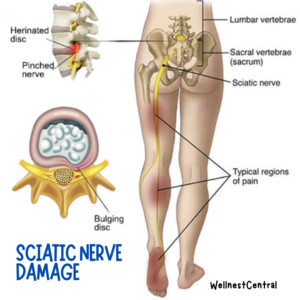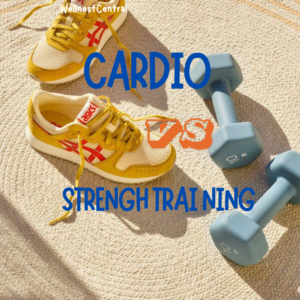Introduction
Sciatic nerve and hip pain can be a debilitating combination that interferes with every aspect of your life. The pain often starts deep in your lower back and radiates through the hip, making simple movements like sitting, standing, or walking feel nearly impossible. When the sciatic nerve is the source, it’s not just about the hip—it’s a larger issue affecting your entire lower body. However, understanding the relationship between the sciatic nerve and hip pain is the key to finding relief. In this guide, we’ll explore the causes, symptoms, and proven steps to help you ease your pain and regain your mobility.
Understanding the Sciatic Nerve and Its Impact on Hip Pain
What Is the Sciatic Nerve?
The sciatic nerve is the largest nerve in your body, originating in the lower back, running through the hips, buttocks, and down each leg. It plays a key role in sensation and movement in the lower extremities. However, when it becomes compressed, irritated, or inflamed, it can cause a condition called sciatica.
How the Sciatic Nerve Causes Hip Pain
When the sciatic nerve is pinched or compressed, it often results in pain that radiates along its pathway. In many cases, the compression happens in the lumbar spine due to issues like herniated discs, spinal stenosis, or even muscle tightness (particularly in the piriformis muscle, which sits deep in the hip). The pain may start in the lower back but quickly spreads to the hip, causing discomfort, burning, or a shooting pain that radiates down the leg.
Real-life Perspective: Meet Kevin, a 35-year-old office worker, who began experiencing hip pain every time he sat for more than 20 minutes. After months of discomfort, he learned the pain was not from his hip but from his sciatic nerve, compressed by a herniated disc.
Common Symptoms of Sciatic Nerve-Related Hip Pain
How Sciatic Hip Pain Feels
Sciatic nerve pain in the hip can feel different from typical hip pain. It often manifests as:
- A sharp or burning sensation.
- Pain that radiates from the lower back to the hip and down the leg.
- A numbness or tingling sensation in the hip or leg.
Symptoms to Watch For
Sciatic hip pain often worsens when sitting, bending, or standing for long periods. Sometimes, hip weakness or a feeling of heaviness in the leg accompanies the pain. People also notice that movements like standing up from a seated position or climbing stairs can trigger a flare-up.
Differentiating Sciatic Hip Pain from Other Hip Conditions
It’s essential to distinguish sciatic hip pain from other conditions like arthritis, hip bursitis, or muscle strains. Unlike localized hip pain, which is often focused on the joint, sciatic nerve pain usually follows a pattern from the lower back, through the hip, and down to the legs.
Proven Steps to Relieve Sciatic Nerve and Hip Pain
Gentle Stretches to Relieve Hip and Sciatic Pain
Stretching the muscles around the sciatic nerve can relieve pressure and reduce pain. A study in the Journal of Pain Research suggests that stretching can effectively alleviate sciatic nerve tension. Here are some targeted stretches:
- Knee-to-Chest Stretch: Lie on your back with both legs bent. Bring one knee up toward your chest, holding the stretch for 20-30 seconds. Switch legs and repeat 2-3 times.
- Hip Flexor Stretch: Start in a kneeling position with one leg in front, bent at a 90-degree angle. Push your hips gently forward until you feel a stretch along the front of your hip and thigh. Hold for 20-30 seconds and switch sides.
- Piriformis Stretch: Sit on the floor, cross one ankle over the opposite knee, and gently lean forward until you feel a stretch in the hip and buttock area. Hold for 15-30 seconds.
These stretches help release tension from the muscles surrounding the sciatic nerve, especially the piriformis, which can compress the nerve when tight.
Strengthening the Core and Hip Muscles
Strong core and hip muscles help stabilize the pelvis and spine, reducing the strain on the sciatic nerve. Try these exercises:
- Clamshells: Lie on your side with your legs bent and feet together. Lift your top knee while keeping your feet together, then lower it back down. Repeat 10-15 times on each side to strengthen the glutes and hips.
- Bridges: Lie on your back with your knees bent and feet flat on the floor. Lift your hips towards the ceiling, squeezing your glutes and core, then slowly lower back down. Repeat 10-15 times to build strength in the lower back, glutes, and core.
The Role of Heat and Cold Therapy
Applying heat to tight muscles around the hip can help relax and soothe tension, while cold therapy can reduce inflammation and numb sharp pain. Applying heat packs or taking warm baths before stretches can enhance flexibility. Use ice packs wrapped in a towel on painful areas for 15-20 minutes, several times a day, especially after activity.
Lifestyle Modifications for Ongoing Relief

Maintaining Good Posture
Good posture reduces pressure on the spine and sciatic nerve. Use these tips to maintain proper alignment:
- When sitting, keep your feet flat on the ground and use a lumbar roll to support your lower back.
- When standing, distribute your weight evenly on both feet, keeping your shoulders back and down.
Avoiding Prolonged Sitting or Standing
Long periods of sitting or standing can worsen sciatic nerve and hip pain. Aim to take breaks every 30-60 minutes to stand, walk, or stretch briefly. If your work requires standing, use a footrest to shift your weight from side to side.
Healthy Body Weight and Its Impact on Sciatica
Excess weight adds pressure to your hips, lower back, and sciatic nerve. Adopting a balanced diet and engaging in regular, low-impact exercises (like walking or swimming) can alleviate this pressure, reduce inflammation, and support hip and back health.
Alternative Therapies and Treatments
Physical Therapy for Sciatic Hip Pain
A physical therapist can assess your condition and guide you through exercises that are safe and effective for sciatic hip pain. Physical therapy can significantly improve strength, flexibility, and function, often leading to long-term relief.
Chiropractic Care and Massage Therapy
Spinal adjustments from a chiropractor can help relieve pressure on the sciatic nerve, while massage therapy can reduce muscle tension around the hips and lower back. Gentle, targeted massage helps improve circulation, reduce inflammation, and promote healing.
Medication and Injections
For those needing additional pain relief, over-the-counter NSAIDs, such as ibuprofen, can help reduce inflammation. In some cases, a healthcare provider may recommend corticosteroid injections for targeted pain relief, particularly if other treatments have not been effective.
Real-Life Stories of Hope and Recovery
Sarah’s Path to Comfort
Sarah, a 45-year-old avid hiker, found herself unable to continue her outdoor adventures due to intense hip pain radiating from her sciatic nerve. After months of frustration, she sought physical therapy and started stretching her hip muscles daily while working on her core strength. Within weeks, Sarah noticed significant improvement, and she was soon back on the trails.
John’s Comeback
John, a 50-year-old accountant, suffered from unbearable hip pain every time he sat for long periods at his desk. By combining chiropractic care, daily stretching, and posture adjustments, he slowly regained his ability to sit comfortably through his workday without flare-ups.
When to Seek Help and Professional Treatment
Signs It’s Time to See a Doctor or Therapist
If your sciatic hip pain is accompanied by increasing leg weakness, numbness, or loss of bowel/bladder control, seek medical attention immediately. These could be signs of a more serious condition like cauda equina syndrome.
Diagnosis and Tests
Healthcare professionals may use imaging tests like MRI or X-rays, and nerve conduction studies, to accurately diagnose the cause of sciatic hip pain and develop a targeted treatment plan.
Conclusion: A Pathway to Comfort and Mobility
Sciatic hip pain can feel overwhelming, but understanding its causes and finding the right steps to relieve it can change your life. With stretches, strengthening exercises, lifestyle modifications, and the right treatments, you can regain comfort and reclaim your mobility. Remember that relief is possible, and hope is not lost—take proactive steps today to improve your quality of life and reduce your hip pain.
Call to Action:
If you’re suffering from sciatic nerve and hip pain, don’t let it hold you back any longer. Try these exercises and lifestyle changes, and consult a healthcare provider for personalized care. Reclaim your freedom to move and live pain-free!




